Volunteers bring so much to organisations. They strengthen communities, boost well-being, and often change lives. Including their own!
However, capturing that impact can feel daunting. Especially when funders want neat numbers, but volunteers deserve recognition that goes deeper than statistics.
The good news? There isn’t just one way to measure impact. At our 2025 Conference, we heard from Joanne Irvine and Will Watt. They’re two leading voices in this area who are approaching volunteer impact from slightly different angles.
Joanne’s work shows how involving volunteers in the process of collecting qualitative data can uncover stories that statistics alone can’t capture. Whereas Will is well-experienced in turning the social and economic value of volunteering into hard data.
By combining storytelling methods with economic evaluation, volunteer managers can build reports that tick boxes for stakeholders while showing the human side too. Here’s how…
Go Beyond Hours Logged
Traditional measures, like the number of hours given or the cost of replacing volunteers with paid staff, are a useful starting point. But they only capture one part of the picture.
- Economic value: Tools like social value calculators can estimate the financial worth of volunteering in terms of improved well-being, health, and community services supported.
Will Watt’s company, State of Life, has developed a simple guide to social impact to help you start thinking about calculating your programme’s social value. - Social impact: Data shows that weekly volunteering boosts life satisfaction, reduces loneliness, and builds trust in communities.
Joanne’s work supports highlighting the human impact behind the numbers. It brings meaning, emotion, and context to outcomes. And by doing so, it supports fairer policies, stronger funding cases, and a shift toward valuing social, environmental, and community well-being alongside economic measures.
Think of hours logged as the foundation, layering in well-being and social impact creates a full story around the data.
Capture Stories and Lived Experiences
Numbers impress funders, but stories move people. Volunteers often describe benefits like:
- Increased confidence
- New friendships
- A stronger sense of purpose
- Better physical and mental health
Simple methods like open-ended questions in feedback forms, sticker voting at events, or even casual conversations can reveal these outcomes. Sharing them alongside statistics creates a fuller, more relatable picture.
See a snippet of Joanne’s work with Glasgow Life below, and read the full report via this link.
Involve Volunteers in Evaluation
When volunteers are invited to help shape how impact is measured, they feel more valued and engaged. This participatory approach:
- Deepens trust and retention
- Uncovers hidden benefits managers may miss
- Helps align evaluation with what truly matters to volunteers
It doesn’t need to be complicated. Something as simple as asking volunteers what success looks like to them can make a difference.
Recognise What Volunteers Want Most
Research into volunteer motivations highlights six recurring themes, captured in the GIVERS framework:
- Growth: opportunities to learn and develop skills
- Impact: evidence that their work makes a difference
- Voice: inclusive language and invitations to help, not just “volunteer recruitment”
- Experience: enjoyable, easy-to-access opportunities
- Recognition: simple thanks and public appreciation
- Social connection: friendships, networks, and reduced loneliness
Designing your evaluation around these motivators ensures you’re measuring (and delivering) what matters most.
Build Reports That Speak to Everyone
Different stakeholders care about different things. A strong impact report should combine:
- Statistics for funders and policymakers: such as the economic value of well-being improvements or the cost saved to public services.
- Stories for communities and volunteers: quotes, case studies, and personal accounts that show the human side of volunteering.
- Practical context: explaining what those numbers and stories mean in real-world terms (e.g. “One volunteer enables nine others to play sport”).
Make your reporting credible, relatable, and actionable with this blended approach.
Final Thoughts
Measuring the impact of volunteers doesn’t have to be a choice between numbers and stories. By blending economic evaluation with qualitative, participatory methods, you can create reports that satisfy funders, inspire communities, and, most importantly, show volunteers how much they matter.
Because the true value of volunteering isn’t just in what people give, it’s also in what they gain.
Find out more
Joanne Irvine
If you want to find out more about Joanne’s work and this approach to measuring the impact of volunteers, you can check out this paper she worked on with Ruth Leonard. You can also see her slides from the Conference here.
Will Watt
Visit State of Life’s website to see how Will might be able to help you measure the social value of your work. You can also see his conference slides here.
And, as always, you can find TeamKinetic via our links below:






